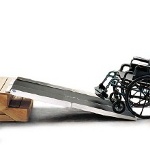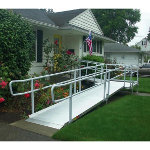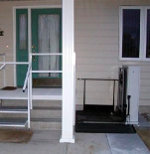The Wheelchair Guide
Your Wheelchair and Mobility Scooter Resource
Improving Staircase Accessibility at Home
Monday, September 28th, 2009
One of the difficulties that often faces those who use mobility scooters and wheelchairs is increasing accessibility at home. Usually, many of the places away from home are made accessible under the Americans with Disabilities Act(ADA,) which is designed to protect, among others, those who use wheelchairs and other mobility vehicles.
Unfortunately, ADA laws do not typically apply to your own home, so it is often necessary to find ways to increase accessibility and make your home more wheelchair friendly.
One of the most difficult areas to access for wheelchair users is the staircase, which can not be easily navigated by most wheelchair users. There are, of course, some who are adept at maneuvering their manual wheelchair over the staircase, but this can be very dangerous, is very difficult, and does not work with most electric wheelchairs. Instead, using a ramp or some sort of wheelchair lift is usually required to increase the accessibility of the homestead.
Choosing between a wheelchair lift and a wheelchair ramp can be a tricky decision, with pros and cons applying to both types of home medical equipment. One of the biggest factors is often the type of staircase.
Short Folding Wheelchair Ramps
 For very short staircases, of only a few steps, a simple metal ramp is the easiest and least expensive option. These come in a variety of designs, but are usually between 3′ and 6′ long. The ramp, which is made out of lightweight metal and usually has a non-skid textured backing, is simply placed onto the landing of the staircase, with some offering lightweight clamps that help hold the ramp in place. The wheelchair user can then drive up or down the ramp, which can be set up or removed in minutes.
For very short staircases, of only a few steps, a simple metal ramp is the easiest and least expensive option. These come in a variety of designs, but are usually between 3′ and 6′ long. The ramp, which is made out of lightweight metal and usually has a non-skid textured backing, is simply placed onto the landing of the staircase, with some offering lightweight clamps that help hold the ramp in place. The wheelchair user can then drive up or down the ramp, which can be set up or removed in minutes.
Many of these types of wheelchair ramps, are designed to be folded up when not in use and can also be used to access some vehicles. These types of ramps, which are sometimes called threshold ramps, but this is not really the correct term, provide a quick and easy way to allow access over short distances. However, for a front porch that is more than a few steps high, these types of wheelchair ramps will not usually work.
Wooden and Modular Metal Wheelchair Ramps
 For larger staircases, a much larger wheelchair ramp is required. These often are custom built out of wood, with many free wheelchair ramp plans available online. Wooden wheelchair ramps are usually a fairly cost effective option and can be built by most handymen. It is also usually possible to hire most carpenters to build a wooden wheelchair ramp.
For larger staircases, a much larger wheelchair ramp is required. These often are custom built out of wood, with many free wheelchair ramp plans available online. Wooden wheelchair ramps are usually a fairly cost effective option and can be built by most handymen. It is also usually possible to hire most carpenters to build a wooden wheelchair ramp.
Another option for larger staircases is to invest in a modular metal wheelchair ramp, which comes in sections that can be fit together quickly and easily. These are typically a great deal more expensive than building your own wheelchair ramp. For commercial use, a concrete wheelchair ramp is much more common than either the wooden or metal ramp design.
As is the case with all wheelchair ramps, the height of the staircase directly relates to how long the wheelchair ramp must be. This can result in very long wheelchair ramps, which sometimes must double back depending on the size of the yard. Even if the ramp does not have a switchback, it can still take up a great deal of space on the front of the home.
Wheelchair Lifts
 Wheelchair lifts are also a popular choice for those who use mobility scooters and electric wheelchairs, with these devices being very similar to an elevator in the way they work. The wheelchair lift, which is referred to as a vertical platform lift in the home medical industry, is placed next to the landing of the staircase, raising and lowering the wheelchair user on a metal platform.
Wheelchair lifts are also a popular choice for those who use mobility scooters and electric wheelchairs, with these devices being very similar to an elevator in the way they work. The wheelchair lift, which is referred to as a vertical platform lift in the home medical industry, is placed next to the landing of the staircase, raising and lowering the wheelchair user on a metal platform.
While in many ways very similar to elevators, vertical platform lifts are actually completely self contained, so they simply must be assembled, placed next to the landing, and plugged in, without major modification to the home. They also take up much less space than a wheelchair ramp would.
Since wheelchair lifts rise vertically and must be placed directly next to the landing, they do not usually work indoors, with the exception of in commercial settings. For most interior residential staircases, an inclined platform lift is required instead, which instead of moving vertically, carries the wheelchair user along the length of the stairway.
Post Categories
- Accessibility Tools (9)
- Electric Wheelchairs (17)
- Health (1)
- manual wheelchairs (10)
- Medicare (2)
- mobility scooters (20)
- vehicle wheelchair lifts (4)
- wheelchair lifts (5)
- wheelchairs (15)
Other Medical Resources
- The Lift Chair Guide
- The Stair Lift Guide
© 2007 - 2025 The Wheelchair Guide | (RSS) | Privacy Policy!